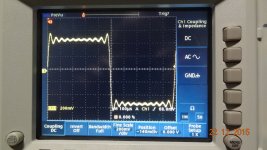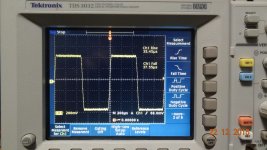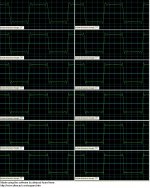You are still under the impression that a LPF will remove/minimize the ripples from a square wave
(and not that the LPF is the reason for generating the ripples)?
Square Wave from Sine Waves - MATLAB & Simulink Example
http://www.ultracad.com/square.htm
Last edited:
And those would be...?
Nothing super special this time.
Louis Barthélémy Champagne Brut Améthyste and a Domaine Drouhin.
No things like 1975 Bollinger Vieilles Vigne Francaise anymore, there's a bottle in London at $3000. Though my eccentric fave Laurent Perrier Ultra Brut is still <$50. Unlike some folks I like non-dose Champagne.
Last edited:
Early here, but the Champagne and pinot noir are ready for dinner.
Enjoy!
I have a great 2008 Rioja I will shortly start on. Thankfully my beautiful wife has expressed a desire for Prosecco. Yes!
I have a friend in London who orders that kind of stuff daily, two and three bottles at a time at three star spots. Ho hum, another lunch break.
I really chose the wrong profession.
Yes, but circa 1977 even I could sit down at Anthony's Pier 4 and order 1973 DRC Montrachet and Musigny Blanc Vogue with my Dover Sole. there were 4 of us and we finished with a 1967 d'Yquem all at $70 a head.
Yes, but circa 1977 even I could sit down at Anthony's Pier 4 and order 1973 DRC Montrachet and Musigny Blanc Vogue with my Dover Sole. there were 4 of us and we finished with a 1967 d'Yquem all at $70 a head.
La Mouline was $15. Sigh.
Full UK fare here today.
Rose Sec Ruinart to start (left over from our Wedding earlier in the year. Chateau de Sales Pomerol (probably past its best by now) (- a gift of 6 bottles - 3 left).
Food...predictable! But good!....and guess, NO MAYO!!!
Same here. Tesco turkey (and very nice it was to) and some £4.99 (or was it £5.99) Cava from Morrison's. Well you have to push the boat out sometimes
Some where I got some of you guys going in the wrong direction with me. Maybe I jumbled pictures with comments.
The additonal LPF at the DAC output that I made cannot have any affect on the creation of the 'Gibb's' ringing.
When I added the filter at the analog output to remove HF, I also saw the Gibb's signal (ringing-like) not at the analog output any more; All removed from entering the PA input.
The end result is a much better output signal. I do not know why that filter was not already at the DAC output of a Mastering machine. I am sure there is a good explanation somewhere.
The analog output is now clean and clear. The PA being used at this time is a Marantz 7025....... I am having built several samples of Damir's (DADOD) wonderful SOTA amp...... a 450v/usec CFA with ultra low distortion at all load and output levels over a very wide bandwidth. I will use it to check any change in distortion and audibles with and without the HF filter. and compare with other VFA of conventional design/performance.
THx-RNMarsh
The additonal LPF at the DAC output that I made cannot have any affect on the creation of the 'Gibb's' ringing.
When I added the filter at the analog output to remove HF, I also saw the Gibb's signal (ringing-like) not at the analog output any more; All removed from entering the PA input.
The end result is a much better output signal. I do not know why that filter was not already at the DAC output of a Mastering machine. I am sure there is a good explanation somewhere.
The analog output is now clean and clear. The PA being used at this time is a Marantz 7025....... I am having built several samples of Damir's (DADOD) wonderful SOTA amp...... a 450v/usec CFA with ultra low distortion at all load and output levels over a very wide bandwidth. I will use it to check any change in distortion and audibles with and without the HF filter. and compare with other VFA of conventional design/performance.
THx-RNMarsh
Last edited:
Here we go againYes, but circa 1977 even I could sit down at Anthony's Pier 4 and order 1973 DRC Montrachet and Musigny Blanc Vogue with my Dover Sole. there were 4 of us and we finished with a 1967 d'Yquem all at $70 a head.
And when Clairborne and Franey had their $4k dinner in Paris at Chez Denis in 1975, the result of winning an Amex auction of a dinner for two anywhere that took the card, they drank a Thenard Montrachet, 1918 Latour, 1928 Mounton, 1929 Romanee Conti (their favorite), 1947 Lafite, 1961 Petrus, and 1928 Yquem, among other things. The food was o.k. too.
The article, which of course inspired widespread indignation, mentioned that most of what they had was available in NYC at retail, with the only really substantial price being 500 dollars for the RC.
I notice the Petrus is still available today and allegedly drinking well. Cost is around 10k.
I bought three bottles of the 1971 for 30 dollars each in 1976 iirc. I have one left. Storage has been good, but like any unrecorked bottle that old there is substantial ullage.
I have a friend in London who orders that kind of stuff daily, two and three bottles at a time at three star spots. Ho hum, another lunch break.
I really chose the wrong profession.
I would almost bet that he is a lawyer!
sans reconstruction
For a hoot read the recent Stereophile review of the latest Audio Note DAC, especially JA's sidebar measurements and comments.You need a brickwall LPF before Fs/2 (in a non-oversampling case) after the DAC even if the input is perfectly band-limited. Nyquist-Shannon does not work without a reconstruction filter.
The DAC output is going to be a series of steps, no matter what. That needs to be filtered to produce the original input.
Money ?I do not know why that filter was not already at the DAC output of a Mastering machine. I am sure there is a good explanation somewhere.
Oh, i should be interested to see the analog square wave signal with and without your LPF. Do-you think you can show them to us ?
And an other question. Did-you set your LPF at the input of tha amp ? If yes, what is his effect (listening impressions) on other signals, like from vinyls ?
Last edited:
Some where I got some of you guys going in the wrong direction with me. Maybe I jumbled pictures with comments.
The additonal LPF at the DAC output that I made cannot have any affect on the creation of the 'Gibb's' ringing.
When I added the filter at the analog output to remove HF, I also saw the Gibb's signal (ringing-like) not at the analog output any more; All removed from entering the PA input.
I'm making dinner now, I will go back over the pictures later. You did not do this at 44.1kHz sampling. Yes the 48kHz Gibbs effect at 96k sampling can be seriously reduced by filtering that still does not touch the audible range. When you burn a Red Book CD the Gibb's at 22.05k will be back. It really would be good to sit down with a good digital audio text.
I would almost bet that he is a lawyer!
Close. Investment banker. He spends more on wine and food in a week than I make in a year.
Money ?
Oh, i should be interested to see the analog square wave signal with and without your LPF. Do-you think you can show them to us ?
And an other question. Did-you set your LPF at the input of tha amp ? If yes, what is his effect (listening impressions) on other signals, like from vinyls ?
The analog signal is from an analog signal generator.... perfect square wave.
I record it via ML9600 analog inputs and then make a CD of it. I play the CD back and look at the analog output from the machine at the RCA/analog output.
In the listening environment, the LPF is used between the analog output of the ML9600 and the analog input to the BenchMark-2 which has its' analog output going to a PA. I do not have an LP system for many years.... too much distortion to my liking.
Before and after:


The ML-9600 does everything a sound card, computer/storage, software, burner and player does in one box. If anyone wants a really well built, sturdy and reliable CD machine just for playback... it is very good and can be bought used for 250-350 USD on eBay. it has hand held remote control, also. Bal-XLR I/O also.
I have it back in my system again and listening to music. I wont do any more work until the second one arrives.
THx-RNMarsh
Last edited:
The analog signal is from a signal generator.... perfect square wave.
What are the rise and fall times of the "before" square wave?
That was my guess.Close. Investment banker. He spends more on wine and food in a week than I make in a year.
Close.
An investment banker who's taken to the cleaners is a sign there's still some justice left in this world, tiny as it may be.
Maybe he'll choke one day, or picked the wrong bad client.
as to how to make this point.
rayma has come to a rescue , thanks Ray.
I used the above software to make the attached screenshot.
I wrote the number of peaks at the top (or bottom) flat of the square wave against the number of harmonics on a sheet of paper.
There is a pattern emerging when looking at the two columns.
Then, by inspection, we can estimate the number of harmonics (H) that the SQRW is composed of by counting the number of peaks (P) visible at the top flat:
H=2P-1
It follows, that we can estimate the number of peaks (P) that will show-up at the top flat when we know the number of harmonics (H) that the square wave contains:
P=(H+1)/2
Enjoy whatever you drink and eat with whoever you are with (and drive carefully afterwards)

George
Attachments
Last edited:
- Status
- Not open for further replies.
- Home
- Member Areas
- The Lounge
- John Curl's Blowtorch preamplifier part II

